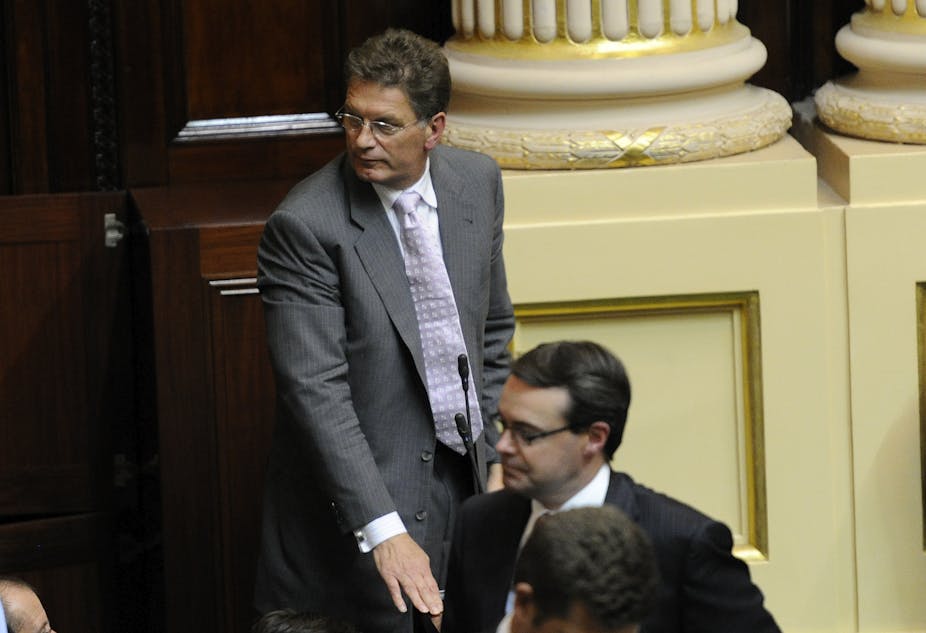One of the key factors in Ted Baillieu’s losing the support of his parliamentary colleagues on Wednesday night was that he failed to manage the media effectively.
Did he?
To find the answers, it is necessary to go back before the election of November 2010, when the Baillieu Government unexpectedly won office.
John Brumby was Premier. It seemed that every night on television he would show up somewhere in a hard hat and high-viz jacket wielding a shovel or gazing through safety glasses at some symbol of Victorian progress. It almost got to the point of self-parody.
Ted Baillieu set his face against this. He was convinced that this kind of political cabaret – what Paul Keating used to call “the switch to vaudeville” – was short-changing the voting public. The voters would reward you, he believed, if you governed well and delivered on your promises. They didn’t want or need media stunts.
At the time, however, all this seemed unlikely to matter. The Brumby government was on the nose but few people seriously thought it was going to lose. Ted Baillieu’s crew found themselves in office under-prepared.
There were delays sorting out ministerial staffs, winnowing out people who were thought to be too close to Labor and replacing them with people the new Government trusted. A high-profile and respected ABC television journalist, Josephine Cafagna, was appointed the Premier’s director of communications.
Like all Victorian governments since John Cain’s (1982-1990), the Baillieu Government centralised its media management in the Premier’s office. But Cain had planned his from Opposition: he knew he was going to win. Baillieu did not have this advantage.
Yet his new media team embarked on what seemed to be a more high-principled approach to media relations than had characterised the old Brumby team: putting an end to old favouritisms, supplying information on request without putting it through the spin cycle, and answering questions factually.
This was all well and good, but it was also accompanied by failure to observe an ancient ritual. To use a phrase employed by the likes of Tom Playford (Premier of South Australia 1938-1965) and Joh Bjelke-Petersen (Premier of Queensland 1968-1987), Ted Baillieu failed to “feed the chooks”.
In other words, he did not make himself available frequently and regularly to the parliamentary press gallery. Cain, by contrast, during his first two years in office held daily meetings with the gallery – a cup of tea, an informal chat, a formal interview. He had a reformist agenda and he needed to sell it.
Baillieu just seemed unable to develop this kind of rapport with journalists. Although pleasant in one-on-one informal encounters, he was edgy and uncomfortable under media scrutiny. To watch him dealing with journalists on television was to watch a man walking on eggshells.
This uneasiness, combined with his inaccessibility, meant the media also became edgy, and among government members political pressure began to build over what they saw as a failure to get the government’s story out.

Some well-reported tensions developed in the Premier’s office, and in December 2011 Baillieu’s senior media adviser, Simon Troeth, left to take a position as head of communications for the Department of Justice.
A month later, in January 2012, Cafagna became executive director of the Premier’s Office, and was replaced as director of communications by Paul Price, another senior media adviser.
All this shuffling and re-shuffling and the government was not much more than a year old.
Then there was a change in strategy. Old favourites were restored. It is understood that members of the media unit on one occasion even attended the internal news conference of one news outlet. For other journalists, however, dealings with the media office became transactional: “You want us to help you. How can you help us?”
This is a recipe for disaster. It looks hard-headed and savvy but it has two certain consequences: it creates resentment among the disfavoured media, and it makes the Government hostage to the goodwill of the favoured media.
The media are not interested in goodwill beyond the minimum necessary to get stories. They certainly have no sense of reciprocal obligation to government. Why would they? Part of their job is to be a watchdog on government.
Through this change, one thing remained constant: Baillieu’s failure to “feed the chooks”.
The picture that emerges is of a man with decent instincts who thought it right to shun media stunts, but who for reasons of shyness or distrust or failure to appreciate the central role of media in the relationship between a government and the public, disengaged as far as he could from this side of his job.
The long-running tensions in his office also suggest disengagement on his part. Engaged bosses head off this kind of dysfunction early.
If this thesis is right, it is part of a wider pattern of disengagement that has been remarked upon in relation to Baillieu’s overall approach to the job.
On Monday this week, disengagement was not an option. The Herald Sun had published taped conversations implicating the Premier’s (now also resigned) chief of staff, Tony Nutt, and the Deputy Premier, Peter Ryan, in activities associated with the removal from office of Simon Overland as Chief Commissioner of Police.
What did Baillieu do? He stood in front of the cameras, taut and upright. No, he had not listened to the incriminating tapes, and yes he had referred the conduct of Tony Nutt to the IBAC. That was it.
Finito.

